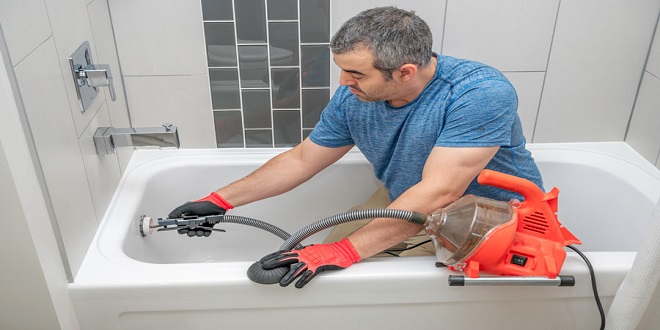How to Fix a Slow Draining Bathtub (3 Simple DIY Solutions )

Are you frustrated to take the shower or sit in the tub and then see it disappear at a slow rate after you’re done?
This is a very frequently encountered issue. It’s good to know that it is fixable in a variety of ways that are usually simple and affordable.
Before we show you how to repair a slow draining bathtub using our three simple solutions, let’s have a look at the reason why it is happening in the first initial place.
5 Reasons Why My Tub Drains Slowly
You’re probably able to guess the reason the drain of your tub gets blocked. Here’s a listing of the most commonly-cited reasons:
Hair. Each every time you wash your hair certain hair falls out and goes down the drain. It’s a fact but we don’t realize it’s occurring. Hair tends to stick to the inner wall of drains. When it gets larger the hair accumulation reduces the drainage, causing the tub will drain slowly…or completely.
Scale. Scale is a short form for limescale which is a type of hard buildup of water minerals. You might have heard it as calcium buildup. Whatever it is the minerals adhere to the surface of the drain’s wall. In addition to slowing the flow of water, it can cause corrosion of the drain.
Soap Scum. We often believe that soap will disappear completely after it has gone to the toilet. However, soap turns into soap scum when it is broken down by water. Since it is composed from fat or grease soap scum becomes sticky. Like hair and scale soap scum adheres to the wall of the drain in the tub and will accumulates over time.
Dirt & Sediment. The shower or bathtub to wash our bodies because we’re filthy. Like soap scum dirt behaves like sediment that flows into the drain. It also adheres to the interior of the drain and collects hair, soap scum and scale.
Drain stopper. Sometimes, the flow of water can be decreased due to the part that is broken or fitting properly. While it is less frequent than the previous causes, a stopper that does not fit correctly could become locked in a closed state that reduces the flow of water.
It’s not easy to spot soap scum within the drains of bathtubs. You’ve probably noticed this buildup in other water-using fixtures , such as your faucet.
How to Fix a Slow Draining Bathtub
Here are four easy methods to efficiently clear an inefficient draining bathtub that is blocked.
- Use a Plunger
- If your tub is fitted with an overflow plate, take it off as well as it’s overflow plates. Connect the overflow hole by using a large, wet rag, or use duct tape to cover the opening. This will stop air from getting out through the opening, thus making plungers more efficient.
- The rim of the plunger should be coated with petroleum jelly. Then, pour enough water in the tub to fill the cup of the plunger.
- The plunger should be inserted so that there is no air beneath it.
- In a few, short strokes make sure you push down and then pull up with the plunger. This should take approximately 20 minutes. Be sure that the plunger cup remains sealed on the drain.
- Repeat the procedure as necessary as needed, up to 6 or 5 times. Patience is essential to plunge the bathtub slowly draining.
- If the obstruction persists continue to the next procedure.
Note that in this instance the overflow is entirely sealed with the duct tape. This stops air from getting released from it and makes plunging more powerful and efficient.
-
User an Auger
- Make sure you have a bucket available to put any debris that has been gathered at the end of the auger for drains.
- If you’re in a shower enclosure take off or pull off the strainer, then work the auger down the opening for drains.
- When you’re in the tub take the stopper off and raise the whole thing. Then, feed the auger through to the tube that is overflowing.
- The auger should be moved around the drain, turning it counterclockwise to remove any blockages.
- Take the auger off slowly, then place the debris into the bucket, then make sure to run the through the bucket to check the drainage.
- If the blockage persists Try the next step.
This video illustrates a variety of ways to fix a slow draining bathtub that include Method #2 and #3 , which are discussed in this article.
-
Use a Hose and Rubber Ball
- The use of a garden hose as well as a rubber ball may sound strange however it’s a great DIY method.
- It is possible to connect the hose onto an outside faucet (this is only possible if the pipe is long enough to extend to the tub drain or perhaps through the window).
- If it’s not feasible you can connect the pipe with an outdoor faucet with an adapter that has threads.
- Shut off all drains in the vicinity and feed the hose into to the tube that is overflowing.
- Put rags in a tight circle around the hose, where it will enter the overflow.
- When you insert the hose, you could be able to see that the tube is too narrow. Make sure to make sure to feed the hose as far into the ground as you can.
- Put the rubber ball on the drain on near the base of the bathtub (if you don’t have a drain connector). This will prevent the water from draining out of the tub when you switch on the water hose.
- Push down with your foot on the drain plug or rubber ball by using your feet to make sure it is sealed.
- Keep the hose in place as a helping hand turns the water to turn it off (at the maximum force).
- Turn the hose on , then off multiple times to flush the obstruction.
If the hose you have isn’t reaching the drain on the tub through an outdoor spigot, then you can connect it to a faucet in the bathroom with a thread adapter like described here.
Discover the essence of crafting captivating magazine content, delving into the art of storytelling and visual aesthetics. Uncover the secrets to engaging readers through compelling narratives and striking imagery, elevating the impact of each page turn. Master the intricacies of magazine creation to resonate with diverse audiences and leave a lasting impression.
Final Thoughts
Fortunately, knowing ways to solve a slow draining tub is simple. In addition, the procedure for each of these procedures is easy and quick.
Of course prevention is the most effective remedy. Be attentive to the causes of why the drain in your bathtub is blocked. Be aware of the kind of debris that is removed during the process of cleaning it (this is easy with an auger technique).





